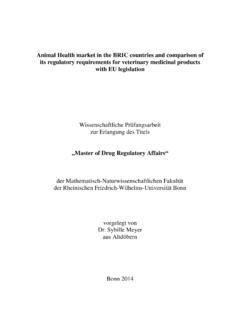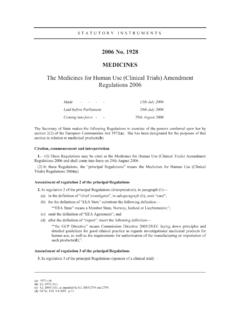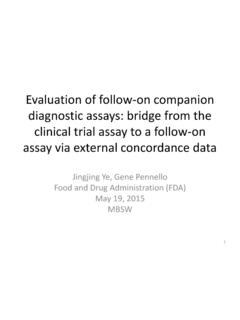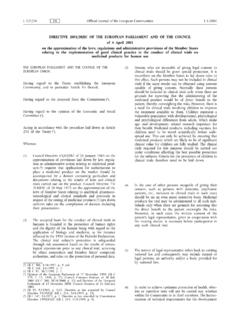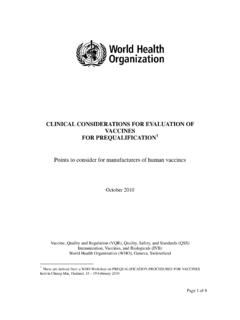Transcription of The new Clinical Trial Regulation and corresponding new EU ...
1 TITLE PAGE The new Clinical Trial Regulation and corresponding new EU portal and database: an opportunity to enhance standardisation and interoperability in regulatory systems Wissenschaftliche Pr fungsarbeit zur Erlangung des Titels Master of Drug Regulatory Affairs der Mathematisch-Naturwissenschaftlichen Fakult t der Rheinischen Friedrich-Wilhelms-Universit t Bonn vorgelegt von Rita Huber aus Geislingen an der Steige Bonn 2015 Page 2 of 48 _____ Betreuer und 1. Referent: Dr. Klaus Menges Zweiter Referent: Dr. Andreas Franken TABLE OF CONTENTS Page 3 of 48 _____ TABLE OF CONTENTS TITLE PAGE .. 1 TABLE OF CONTENTS .. 3 TABLE OF FIGURES .. 5 LIST OF ABBREVIATIONS .. 6 1. INTRODUCTION .. 8 AIMS AND OBJECTIVES .. 8 METHODS .. 9 2. STANDARDISATION AND INTEROPERABILITY .. 10 STANDARDISATION .. 10 Within systems .. 11 Across systems .. 11 INTEROPERABILITY .. 12 EUROPEAN AND INTERNATIONAL INITIATIVES .. 13 Europe.
2 13 International .. 16 Standards developing organisations (SDOs) .. 18 3. Clinical TRIALS AUTHORISATION IN THE EU .. 19 Clinical TRIALS DIRECTIVE STATUS QUO .. 19 EudraCT .. 19 Process for Clinical Trial Application according to the Directive .. 20 NEW Clinical Trial Regulation .. 20 Clinical Trial Application (CTA) .. 22 EU Portal and Database .. 22 4. RESULTS - STANDARDISATION AND INTEROPERABILITY NEW Clinical Trial Regulation .. 25 ELECTRONIC APPLICATION FORM (EAF).. 25 INVESTIGATIONAL MEDICINAL PRODUCT DOSSIER (IMPD) .. 27 TABLE OF CONTENTS Page 4 of 48 _____ XEVMPD/ISO-IDMP AND SAFETY REPORTING .. 29 RPS / ECTD .. 33 5. DISCUSSION .. 35 STANDARDISATION AND INTEROPERABILITY .. 35 EU PORTAL AND DATABASE .. 36 Master data - 38 eAF .. 39 CTA and RPS .. 39 TIMELINES AND CHALLENGES .. 41 6. CONCLUSION AND OUTLOOK .. 43 7. SUMMARY .. 44 8. REFERENCES .. 45 TABLE OF FIGURES Page 5 of 48 _____ TABLE OF FIGURES Figure : 1 High level overview of the Clinical Trial systems.
3 23 Figure : 1 Conceptual overview IDMP .. 31 Figure : 2 Work in Progress: SPOR data and IDMP .. 32 Figure : 1 Harmonisation of submission data standards .. 37 LIST OF ABBREVIATIONS Page 6 of 48 _____ LIST OF ABBREVIATIONS ANSI American National Standards Institute CAP Centrally Authorised Product CEN Comit Europ en de Normalisation, European Committee for Standardisation CENELEC Comit Europ en de Normalisation lectrotechnique, European Committee for Electrotechnical Standardisation CSR Clinical Study Report CT Clinical Trial CTA Clinical Trial Application CTD Common Technical Document CTP Clinical Trial Protocol CTR Clinical Trial Regulation eAF electronic Application Form EC European Commission eCTD electronic Common Technical Document EDQM European Directorate for the Quality of Medicines and Healthcare EEA European Economic Area EFPIA European Federation of Pharmaceutical Industries and Associations EHR Electronic Health Record EMA European Medicines Agency EMB EMA Management Board ESTRI Electronic Standards for the Transfer of Regulatory Information ETSI European Telecommunications Standards Institute EU European Union EUCTR EU Clinical Trials Register EudraCT European Union Drug Regulating Authorities Clinical Trials EUNDB European Union Network Data Board EURECA Enabling information re-Use by linking Clinical REsearch and Care EUTCT European Union
4 Telematics Controlled Terms EVCTM EudraVigilance Clinical Trial Module FDA Food and Drug Administration (US) GInAS Global Ingredient Archival System HIMSS Healthcare Information and Management Systems Society HL7 Health Level 7 HMA Heads of Medicines Agencies IB Investigator s Brochure ICD International Classification of Diseases ICH International Conference on Harmonisation of Technical Requirements for Registration of Pharmaceuticals for Human Use IDMP Identification of Medicinal Product IEC International Electrotechnical Commission IHTSDO International Health Terminology Standards Development Organisation IMP Investigational Medicinal Product IMPD Investigational Medicinal Product Dossier IND Investigational New Drug application ISO International Standards Organisation/International Organisation for Standardisation LIST OF ABBREVIATIONS Page 7 of 48 _____ IT Information Technology ITU International Telecommunication Unit IDMP Identification of Medicinal Product MAA Marketing Authorisation Application MDM Master Data Management MedDRA Medical Dictionary
5 For Regulatory Activities MP Medicinal Product MPD Medicinal Product Dictionary NCATS National Center for Advancing Translational Sciences NeeS Non-eCTD electronic Submission NIH National Institutes of Health NMV Next Major Version RPS Regulated Product Submission SDO Standards Developing Organisation SPOR Substances, Products, Organisations and Referential SUSAR Suspected Unexpected Serious Adverse Reaction USA United States of America WHO World Health Organisation XEVMPD Extended EudraVigilance Medicinal Product Dictionary XML Extensible Markup Language 1. INTRODUCTION Page 8 of 48 _____ 1. INTRODUCTION In 2004 Clinical Trial Directive 2001/20/EC [1] came into force to regulate the execution of Clinical trials (CTs) in the European Union (EU). The Directive was a big step forward in regulating the assessment, performance and recording of CTs but experience with the process over the last several years has indicated that a new approach is needed.
6 Therefore the new EU Clinical Trial Regulation 536/2014 (CTR) [2] was introduced in 2014 (but will not be applied until 2016). The new Regulation , which replaces the Directive, defines a single submission process for CT applications with an overall streamlined assessment. The current Clinical trials database EudraCT will be replaced in the long term by a new EU portal and database for submission and storage of data for Clinical trials. The new portal and database have to be set up as completely new IT systems by the European Medicines Agency (EMA). These systems will be used to collect data about planned and already performed Clinical trials. Entry will be made directly via the portal by the sponsor, the Member States of the EU or the European Commission (EC). These data will be stored in the EU database and a great part of the contents of the database will also be made accessible to the public t o improve the transparency of Clinical trials.
7 AIMS AND OBJECTIVES In light of the growing importance of standardisation and interoperability in the EU and worldwide due to the increase of complexity, the rising numbers of systems and the growing amount of data, this thesis analyses the role of EU regulatory initiatives in this field, such as different roadmaps, for the introduction of the new Regulation . The thesis takes a closer look into the possibilities of where standards can and will be used in the implementation of the new Regulation . It aims to demonstrate where and how the new systems, coming with the Regulation , can be enabled to interoperate with other systems in the European regulatory systems landscape. 1. INTRODUCTION Page 9 of 48 _____ METHODS In order to demonstrate in general the impact of standardisation and interoperability in the EU and internationally, different ways of standardisation and available standards are described at the beginning of the thesis. Afterwards, some initiatives in the EU and worldwide to promote interoperability are presented.
8 This includes the presentation of several roadmaps initiated by the European Medicines Agency (EMA) which are relevant for the enhancement of interoperability for the different regulatory systems in the EU. To obtain an impression of the major changes the new legislation will implement from a technical perspective, the current Directive and the new Regulation are briefly described in one section with regard to these aspects. The functional specifications for the set-up of an EU portal and database developed by the EMA were reviewed regarding relevant important aspects for the use of standards. Technical requirements in connection with possible ways to use already existing standards in the portal and database are presented. The fields where the new database can interoperate with existing or future systems by the use of already introduced or coming standards ( IDMP) are highlighted to demonstrate the possible enhancement of standardisation and interoperability.
9 2. STANDARDISATION AND INTEROPERABILITY Page 10 of 48 _____ 2. STANDARDISATION AND INTEROPERABILITY The regulatory landscape consists of many different regulatory computer systems which store, process and present data and information about medicinal products, regulatory activities and, for example, Clinical trials. These systems are also used to exchange and analyse data ( for pharmacovigilance). The more frequent and complex regulatory systems become, the more it is essential to use standardised ways to describe information and to use standardised processes. Good management of regulatory information is only possible when sensible standards are used. Using the same standards across different systems and being able to exchange data is one of the prerequisites for the interoperability of regulatory systems. STANDARDISATION Standards help to structure information, processes and the exchange of data. There are several different kinds of standards in information systems [3]; the important ones include: Terminology standards: Standards for vocabularies and terminologies describe the meaning of words with codes for terminologies and classifications, EUTCT, ICD-10 Standards for structure: These standards enable computers to extract single pieces of information from a larger set of information, IDMP, MedDRA, CTD Messaging standards: Standards to exchange/transport information from one system to another, xml standards, HL7, eCTD, eAF 2.
10 STANDARDISATION AND INTEROPERABILITY Page 11 of 48 _____ Within systems If standards for vocabularies/terminologies are used within one system, controlled entry and storage of data can be achieved. On the other hand, if standardisation is disregarded and, for example, different terms are used for identical information, this can lead to duplicated or unstructured entries of information. In its turn, this results in difficulties searching for information in a system if the precise term is not known. Hence, it is also problematic to perform a proper analysis of data because either a data set is used twice for the analysis (if the same entry is described using different expressions) or not at all because the analysis does not recognise the term in the respective context. That means, important information for an analysis can get lost due to a different description of information or usage of terms and therefore the analysis remains incomplete and cannot give a reliable result.







